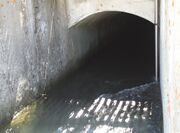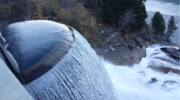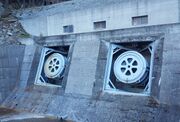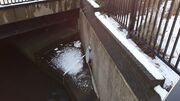Proposal:Outlets proposal
| Outlets proposal | |
|---|---|
| Proposal status: | Approved (active) |
| Proposed by: | fanfouer |
| Tagging: | outlet=* |
| Applies to: | |
| Definition: | Propose a new key to map with details culverts or pipeline outlets releasing fluids |
| Statistics: |
|
| Draft started: | 2020-12-13 |
| RFC start: | 2021-09-18 |
| Vote start: | 2021-10-28 |
| Vote end: | 2021-11-11 |
Outlets are key features in some fluid management infrastructure and have influence on how culverts or pipeline are operated.
They are obvious in water management and regard many other fluids as well. This proposal only focuses on liquids to begin with and gases outlets will be documented in a further proposal.
They mark a punctual limit between a closed duct (pipeline, tunnel mainly) and open air channel and thus sometimes a limit between artificial and natural waterways.
Proposal
It is proposed to use a new outlet=* key on nodes only to describe how a closed duct (like a culvert, a tunnel or pipeline) outlet significantly releasing a fluid without further continuation is shaped or protected, whatever the liquid substance going through can be.
The fluid flow can be intermittent or not.
This proposal only regards outlets where a liquid permanently goes out a duct or a machine with no mean to extend the duct at this point. Anyway from a closed space to open air channel. Gases outlets will be studied in a further proposal when all situation will have been documented. Faucets, sockets intended to plug mobile or flexible pipes (for any use, both domestic or industrial) aren't covered as the fluid isn't supposed to get out the pipe there.
Another proposal regards Inlets as they have different functions as the fluid goes in the pipe or culvert.
Additional valve=* values may be required to be used on particular outlets. They will be approved once this proposal reviewed:
- hollow_jet for valves intended to spread a wide amount of fluid when opened as to avoid erosion issues
- check for valves that are normally opened to let fluids go in a single direction over a given pressure and closed when it goes backward.
Rationale
The proposed tagging key-value pairs will describe the interface/boundaries between fluid channelling systems and open air with greater detail.
At the moment, there does not exist a unified attempt to map this information which could be primarily for environmental reasons. For instance, evaluating a particular watershed's ability to drain water while minimizing erosion or the ability of a culvert or pipeline outlets to effectively filter debris out of the water or ventilation flow.
From a more particular water perspective, this proposal will help further other water_works=* proposal to better document infrastructure and equipment related to the acquisition, storage, treatment and diversion of water resources. Specifically, this proposal addresses the release of water from artificial ducts into natural environment.
No substance on outlets
Proposed outlet=* is intended for the largest variety of fluids going through. OSM mappers are kindly invited to only tag outlet according to their own properties.
Knowledge of the fluid coming out of the outlet is a matter for the pipe or tunnel network the outlet is a member of.
As a consequence, it is not recommended nor desired to reproduce values of substance=* or usage=* related to pipe on the outlet's node. Such data could easily be reproduced on pre-processing.
However, as there are situations where an outlet can be the only visible part of a larger underground infrastructure network that we are unable to map in OSM for various reasons, it would be possible to add substance=* on the outlet when mapped on a stand-alone node without be member of a tunnel or a pipeline way feature.
Outfalls
OSM already documents outfalls with man_made=outfall, referring to places where sewage or rivers discharge into water bodies like lakes, seas or oceans. Water can come from a pipeline, a drain, an open air canal or whatever duct.
This terminology only regards water/sewage while this proposal isn't focused on a precise fluid.
Furthermore, outfalls can refer to open air ducts leading to a water body whereas outlets are dedicated to closed ducts like pipelines or tunnels.
An outfall can be an outlet and an outlet isn't necessarily an outfall.
As a consequence, this proposal will properly refer to man_made=outfall and encourage its use on appropriate situations but won't change its review status.
Check valves
Check valves are particular valves that only allows fluid to flow in one fixed direction. There are several natures of such valves. It encompasses anti-return flapper (to prevent tides getting in a drainage system for instance) to safety checks and water pipe air vents.
This proposal only introduces valve=check and we may need to better classify them with a further sub tag that will remain to be defined.
Faucets aren't outlets
Someone could think pluggable faucets are actual outlets. This proposal states an outlet should be a significant and a permanent exit (intermittently flowing or not) to an open air environment.
As modern faucets may be intended to plug some flexible and mobile pipe, it's not recommended to consider them as outlets.
Decorative fountains may prevent to plug any pipe on them and could be considered as outlet as water hasn't any other option to fall in a basin or continues flowing elsewhere.
Most of them should refer to outlet=direct which is the default value.
Tagging
Put a node at the junction between a culvert, pipeline and their open air downstream fluid way and use outlet=* to describe how this outlet is shaped.
| Key | Value | Comment |
|---|---|---|
| outlet=* | direct | The default outlet with no particular feature. The fluid goes directly downstream |
| screen | A strainer or solid trash screen is installed to prevent solid matter, possibly waste, to go downstream or intrusion inside the upstream pipe/tunnel | |
| sock | A flexible net intended to catch solid matter, possibly waste, and prevent it to go downstream | |
| valve | A valve, including sluice gates, control the flow of a pipe, tunnel or canal outlet | |
| bell_mouth | Bell mouth design intended to spread water flow as to reduce speed and friction when going out of a pressurised duct | |
| noise_barrier | A flexible curtain is installed at the duct outlet as to prevent heavy sound to disturb neighbourhood. | |
| yes | Any unspecified outlet |
Depending whether the outlet can be moved or not, it is possible to use existing actuator=* or handle=* with it.
Depending on outlet dimension, it is also possible to complete with appropriate diameter=*, height=* or width=*.
Valves
Some special valves are currently missing and could be added to valve=*
| Key | Value | Comment |
|---|---|---|
| valve=* | hollow_jet | Valves that spread a dense flow of fluid in several directions as to prevent any downstream damage or erosion |
| check | Valves that normally allow fluid to flow in a single direction when exceeding a given pressure and closing when it goes backward. |
Particularly about hollow_jet, it will require outlet=valve as such valves will be always found at ducts' end. It always meets requirements for an actual outlet:
- Significant amount of fluid is expected through this kind of valve (so significant it needs to be dispersed).
- No ability to continue piping directly after the valve. The flow is dispersed on purpose as to not damage downstream environment.
Edition management
Affected pages
- Create outlet=* page and appropriate values
- Create valve=hollow_jet page
- Create valve=check page
- Edit man_made=outfall page and add combinations with outlet=*
Values to be replaced
No values are proposed for replacement in this proposal
Examples
Culverts or tunnels
| Photo | Location | Tagging | Comments |
|---|---|---|---|
 |
France | A direct outlet of a flooded tunnel | |
 |
UK | A trash screen is used to prevent any big waste to go in a river from a culvert outlet. | |
| Lack of free illustration See this |
Australia | A flexible net fills accordingly to trash flow coming from a drain tunnel. | |
 |
France | This bell mouth spread water as to prevent slope erosion of downstream stream due to high flow rate coming from the duct. Here man_made=outfall remains valid as you can see the lake the water is going in in the picture background. | |
 |
USA | A gate is controlling flow through an outlet of a discharge tunnel of Hoover Dam. See it closed below | |
 |
Switzerland | This big curtain is flexible and adapts to the outflow water level as for preventing noise coming from a hydroelectric power plant to get out the tunnel. |
Pipelines
None of these situations indicates the water reach a water body, so no combination with man_made=outfall is made.
See also
- Inlet and Outlet Transitions for Canals and Culverts from Department of the Interior, Denver, Colorado
- How to map outfalls from New-York State, USA documentation.
Voting
Voting on this proposal has been closed.
It was approved with 20 votes for, 0 votes against and 0 abstentions.
 I approve this proposal. --Rskedgell (talk) 17:56, 28 October 2021 (UTC)
I approve this proposal. --Rskedgell (talk) 17:56, 28 October 2021 (UTC) I approve this proposal. --Fizzie41 (talk) 21:43, 28 October 2021 (UTC)
I approve this proposal. --Fizzie41 (talk) 21:43, 28 October 2021 (UTC) I approve this proposal. --Dearrude (talk) 02:54, 29 October 2021 (UTC)
I approve this proposal. --Dearrude (talk) 02:54, 29 October 2021 (UTC) I approve this proposal. --GeoMechain (talk) 06:37, 29 October 2021 (UTC)
I approve this proposal. --GeoMechain (talk) 06:37, 29 October 2021 (UTC) I approve this proposal. --Fanfouer (talk) 08:11, 29 October 2021 (UTC)
I approve this proposal. --Fanfouer (talk) 08:11, 29 October 2021 (UTC) I approve this proposal. --快乐的老鼠宝宝 (talk) 11:34, 29 October 2021 (UTC)
I approve this proposal. --快乐的老鼠宝宝 (talk) 11:34, 29 October 2021 (UTC) I approve this proposal. --Zorglubu (talk) 07:45, 30 October 2021 (UTC)
I approve this proposal. --Zorglubu (talk) 07:45, 30 October 2021 (UTC) I approve this proposal. --Lenny (talk) 09:26, 01 November 2021 (UTC)
I approve this proposal. --Lenny (talk) 09:26, 01 November 2021 (UTC) I approve this proposal. --AlexModesto73 (talk) 12:04, 1 November 2021 (UTC)
I approve this proposal. --AlexModesto73 (talk) 12:04, 1 November 2021 (UTC) I approve this proposal. --IanVG (talk) 12:14, 3 November 2021 (UTC)
I approve this proposal. --IanVG (talk) 12:14, 3 November 2021 (UTC) I approve this proposal. --Renecha (talk) 21:44, 6 November 2021 (UTC)
I approve this proposal. --Renecha (talk) 21:44, 6 November 2021 (UTC) I approve this proposal. --BlueG (talk) 11:46, 7 November 2021 (UTC)
I approve this proposal. --BlueG (talk) 11:46, 7 November 2021 (UTC) I approve this proposal. i assume that outlet=* is only tagged in combination with man_made=outlet --Kenji (talk) 17:58, 7 November 2021 (UTC)
I approve this proposal. i assume that outlet=* is only tagged in combination with man_made=outlet --Kenji (talk) 17:58, 7 November 2021 (UTC) I approve this proposal. --PeterPan99 (talk) 21:51, 7 November 2021 (UTC)
I approve this proposal. --PeterPan99 (talk) 21:51, 7 November 2021 (UTC) I approve this proposal. --Eginhard (talk) 08:08, 8 November 2021 (UTC)
I approve this proposal. --Eginhard (talk) 08:08, 8 November 2021 (UTC) I approve this proposal. --Reino Baptista (talk) 11:11, 8 November 2021 (UTC)
I approve this proposal. --Reino Baptista (talk) 11:11, 8 November 2021 (UTC)
 I approve this proposal. --Wetterauer (talk) 05:36, 9 November 2021 (UTC)
I approve this proposal. --Wetterauer (talk) 05:36, 9 November 2021 (UTC) I approve this proposal. --AnakinNN (talk) 08:40, 9 November 2021 (UTC)
I approve this proposal. --AnakinNN (talk) 08:40, 9 November 2021 (UTC) I approve this proposal. I've always wanted to see OSM be more detailed in culvert mapping, but too lazy to write a proposal. I like this proposal and I think it is well written and would be a useful addition to the map. --SherbetS (talk) 03:24, 10 November 2021 (UTC)
I approve this proposal. I've always wanted to see OSM be more detailed in culvert mapping, but too lazy to write a proposal. I like this proposal and I think it is well written and would be a useful addition to the map. --SherbetS (talk) 03:24, 10 November 2021 (UTC) I approve this proposal. --Gendy54 (talk) 20:53, 10 November 2021 (UTC)
I approve this proposal. --Gendy54 (talk) 20:53, 10 November 2021 (UTC)






